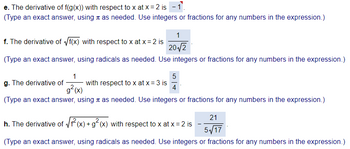Suppose that functions f and g and their derivatives with respect X to x have the values shown to the right at x = 2 and x= 3. Find the derivatives with respect to x of the combinations below at the 2 given values of x. 3 a. 3f(x), x=2 e. f(g(x)), x=2 b. f(x) + g(x), x= 3 f. √f(x), x=2 c. f(x) g(x), x= 3 g. 1 g²(x) x=3 f(x) 8 1 g(x) 2 -2 d. f'(x) 15 x = 2 Зл f(x) g(x) h. √₁²(x)+g² (x), x=2 g'(x) -5 5
Suppose that functions f and g and their derivatives with respect X to x have the values shown to the right at x = 2 and x= 3. Find the derivatives with respect to x of the combinations below at the 2 given values of x. 3 a. 3f(x), x=2 e. f(g(x)), x=2 b. f(x) + g(x), x= 3 f. √f(x), x=2 c. f(x) g(x), x= 3 g. 1 g²(x) x=3 f(x) 8 1 g(x) 2 -2 d. f'(x) 15 x = 2 Зл f(x) g(x) h. √₁²(x)+g² (x), x=2 g'(x) -5 5
Calculus: Early Transcendentals
8th Edition
ISBN:9781285741550
Author:James Stewart
Publisher:James Stewart
Chapter1: Functions And Models
Section: Chapter Questions
Problem 1RCC: (a) What is a function? What are its domain and range? (b) What is the graph of a function? (c) How...
Related questions
Question
100%
Can I ask for help with specifically the last four subparts? (e, f, g, h)

Transcribed Image Text:Suppose that functions f and g and their derivatives with respect
to x have the values shown to the right at x = 2 and x = 3. Find
the derivatives with respect to x of the combinations below at the
given values of x.
a. 3f(x), x = 2
e. f(g(x)), x=2
b. f(x) + g(x), x = 3
f. √f(x), x=2
g.
c. f(x) g(x), x= 3
1
g² (x)
1
X
x = 3
2
3
f(x)
8
1
d.
g(x)
2
- 2
f(x)
g(x)'
f'(x)
1
5
3π
x=2
g'(x)
- 5
5
h. √₁²(x)+g² (x), x=2
Expert Solution
This question has been solved!
Explore an expertly crafted, step-by-step solution for a thorough understanding of key concepts.
Step by step
Solved in 3 steps with 3 images

Follow-up Questions
Read through expert solutions to related follow-up questions below.
Follow-up Question
(Not a question, I just couldn't submit photos in feedback)
None of your given answers were correct. I tried searching for additional help and found this.
https://www.bartleby.com/solution-answer/chapter-3.1-problem-62e-

Transcribed Image Text:e. The derivative of f(g(x)) with respect to x at x = 2 is -1.
(Type an exact answer, using as needed. Use integers or fractions for any numbers in the expression.)
1
f. The derivative of √f(x) with respect to x at x = 2 is
20√/2
(Type an exact answer, using radicals as needed. Use integers or fractions for any numbers in the expression.)
1
g² (x)
(Type an exact answer, using as needed. Use integers or fractions for any numbers in the expression.)
g. The derivative of
with respect to x at x = 3 is
5
4
h. The derivative of √1²(x) + g² (x) with respect to x at x = 2 is
21
(Type an exact answer, using radicals as needed. Use integers or fractions for any numbers in the expression.)
5√17
Solution
Recommended textbooks for you

Calculus: Early Transcendentals
Calculus
ISBN:
9781285741550
Author:
James Stewart
Publisher:
Cengage Learning

Thomas' Calculus (14th Edition)
Calculus
ISBN:
9780134438986
Author:
Joel R. Hass, Christopher E. Heil, Maurice D. Weir
Publisher:
PEARSON

Calculus: Early Transcendentals (3rd Edition)
Calculus
ISBN:
9780134763644
Author:
William L. Briggs, Lyle Cochran, Bernard Gillett, Eric Schulz
Publisher:
PEARSON

Calculus: Early Transcendentals
Calculus
ISBN:
9781285741550
Author:
James Stewart
Publisher:
Cengage Learning

Thomas' Calculus (14th Edition)
Calculus
ISBN:
9780134438986
Author:
Joel R. Hass, Christopher E. Heil, Maurice D. Weir
Publisher:
PEARSON

Calculus: Early Transcendentals (3rd Edition)
Calculus
ISBN:
9780134763644
Author:
William L. Briggs, Lyle Cochran, Bernard Gillett, Eric Schulz
Publisher:
PEARSON

Calculus: Early Transcendentals
Calculus
ISBN:
9781319050740
Author:
Jon Rogawski, Colin Adams, Robert Franzosa
Publisher:
W. H. Freeman


Calculus: Early Transcendental Functions
Calculus
ISBN:
9781337552516
Author:
Ron Larson, Bruce H. Edwards
Publisher:
Cengage Learning